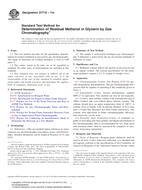Potřebujeme váš souhlas k využití jednotlivých dat, aby se vám mimo jiné mohly ukazovat informace týkající se vašich zájmů. Souhlas udělíte kliknutím na tlačítko „OK“.
ASTM D3523-92(2012)
Standard Test Method for Spontaneous Heating Values of Liquids and Solids (Differential Mackey Test) (Withdrawn 2017)
Automaticky přeložený název:
Standardní zkušební metoda pro samovznícení hodnoty kapalin a pevných látek (Differential Mackey test)
NORMA vydána dne 15.4.2012
Informace o normě:
Označení normy: ASTM D3523-92(2012)
Poznámka: NEPLATNÁ
Datum vydání normy: 15.4.2012
Kód zboží: NS-23948
Počet stran: 4
Přibližná hmotnost: 12 g (0.03 liber)
Země: Americká technická norma
Kategorie: Technické normy ASTM
Kategorie - podobné normy:
Anotace textu normy ASTM D3523-92(2012) :
Keywords:
Differential Mackey Test, liquids, solids, spontaneous heating, spontaneous heating values, Cellulose and cellulose derivatives, Differential Mackey test, Enthalpy, Fibrous materials, Heating tests--petroleum products, Ignition--petroleum products, Liquids, Mackey test, Nonadiabatic determination, Solids content, Spontaneous heating values (SHV), Temperature tests--petroleum products, Thermal analysis (TA)--petroleum products, ICS Number Code 75.160.01 (Fuels in general)
Doplňující informace
| Significance and Use | ||
|
The spontaneous heating value of a substance is a measure of the ability of that substance to undergo self-heating reactions while supported by cellulosic or other fibrous material in air. It is an index of the autoignition tendency of the substance under such conditions. |
||
| 1. Scope | ||
|
1.1 This test method covers the non-adiabatic determination of the spontaneous heating values (SHV) of liquids and solids. It is applicable to substances that are not completely volatile at the test temperature. Spontaneous heating values obtained by this test method are qualitative indications of the degree of self-heating that may be expected to occur upon exposure of the sample to air at the test temperature. 1.2 Values obtained by this method are applicable to liquids and solids supported on cellulosic surfaces. They are not applicable to liquids on metal surfaces, on contaminated surfaces, or at pressures above atmospheric. 1.3 Spontaneous heating values determined by the present test method are regarded only as qualitative measurements of self-heating which occurs under the conditions of the test. The test method does not purport to produce a quantitative measure of the enthalpy of reaction of the sample with air at a given test temperature. Such data can be obtained by the use of an adiabatic calorimeter. The existence, under the test conditions, of a positive temperature difference between the sample and the reference is evidence of a thermochemical reaction in the sample. 1.4 The magnitude of the measured temperature difference is a semiquantitative indication of the enthalpy and rate of that reaction. Since factors such as heat loss from the sample to the bath and quenching of the reaction due to too rapid consumption of oxygen affect the amount and duration of the measured heat effect, care must be taken not to attribute too much quantitative significance to the test results. It is sufficient, for the purpose of this test, to determine whether or not the sample is capable of undergoing a self-heating reaction of sufficient magnitude and rapidity to produce a detectable thermal effect. The spontaneous heating value (SHV) can be lower than the test temperature. A negative result does not preclude spontaneous heating initiating at a temperature higher than the test temperature. 1.5 This standard should be used to measure and describe the response of materials, products, or assemblies to heat and flame under controlled conditions and should not be used to describe or appraise the fire-hazard or fire-risk of materials, products, or assemblies under actual fire conditions. However, results of this test may be used as elements of a fire-hazard assessment or a fire-risk assessment which takes into account all of the factors which are pertinent to an assessment of the fire hazard or fire risk of a particular end use. 1.6 The values stated in SI units are to be regarded as the standard. In cases where materials, products or equipment are available in inch-pound units only, SI units are omitted. 1.7 This standard does not purport to address all of the safety concerns, if any, associated with its use. It is the responsibility of the user of this standard to establish appropriate safety and health practices and determine the applicability of regulatory limitations prior to use. |
||
| 2. Referenced Documents | ||
|
Podobné normy:
Historická
1.6.2012
Historická
15.6.2013
Historická
24.4.2012
Historická
1.10.2011
Doporučujeme:
Aktualizace technických norem
Chcete mít jistotu, že používáte pouze platné technické normy?
Nabízíme Vám řešení, které Vám zajistí měsíční přehled o aktuálnosti norem, které používáte.
Chcete vědět více informací? Podívejte se na tuto stránku.



 ASTM D5504-12
ASTM D5504-12 ASTM D6824-13e1
ASTM D6824-13e1 ASTM D7666-12
ASTM D7666-12 ASTM D7716-11a
ASTM D7716-11a
 Cookies
Cookies
